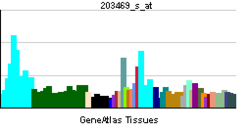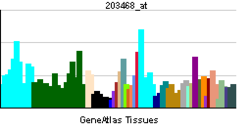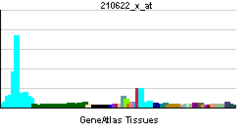- Cyclin-dependent kinase 10
-
Cyclin-dependent kinase 10 Identifiers Symbols CDK10; PISSLRE External IDs OMIM: 603464 MGI: 2448549 HomoloGene: 55769 GeneCards: CDK10 Gene EC number 2.7.11.22 Gene Ontology Molecular function • nucleotide binding
• cyclin-dependent protein kinase activity
• protein binding
• ATP bindingBiological process • traversing start control point of mitotic cell cycle
• negative regulation of cell proliferationSources: Amigo / QuickGO RNA expression pattern 


More reference expression data Orthologs Species Human Mouse Entrez 8558 234854 Ensembl ENSG00000185324 ENSMUSG00000033862 UniProt Q15131 Q0VGZ8 RefSeq (mRNA) NM_001098533.2 NM_194444 RefSeq (protein) NP_001092003.2 NP_919426 Location (UCSC) Chr 16:
88.28 – 88.29 MbChr 8:
125.75 – 125.76 MbPubMed search [1] [2] Cell division protein kinase 10 is an enzyme that in humans is encoded by the CDK10 gene.[1][2][3]
The protein encoded by this gene belongs to the CDK subfamily of the Ser/Thr protein kinase family. The CDK subfamily members are highly similar to the gene products of S. cerevisiae cdc28, and S. pombe cdc2, and are known to be essential for cell cycle progression. This kinase has been shown to play a role in cellular proliferation. Its function is limited to cell cycle G2-M phase. At least three alternatively spliced transcript variants encoding different isoforms have been reported, two of which contain multiple non-AUG translation initiation sites.[3]
Contents
Interactions
Cyclin-dependent kinase 10 has been shown to interact with ETS2.[4]
References
- ^ Grana X, Claudio PP, De Luca A, Sang N, Giordano A (Jul 1994). "PISSLRE, a human novel CDC2-related protein kinase". Oncogene 9 (7): 2097–103. PMID 8208557.
- ^ Brambilla R, Draetta G (Oct 1994). "Molecular cloning of PISSLRE, a novel putative member of the cdk family of protein serine/threonine kinases". Oncogene 9 (10): 3037–41. PMID 8084611.
- ^ a b "Entrez Gene: CDK10 cyclin-dependent kinase (CDC2-like) 10". http://www.ncbi.nlm.nih.gov/sites/entrez?Db=gene&Cmd=ShowDetailView&TermToSearch=8558.
- ^ Kasten, M; Giordano A (Apr. 2001). "Cdk10, a Cdc2-related kinase, associates with the Ets2 transcription factor and modulates its transactivation activity". Oncogene (England) 20 (15): 1832–8. doi:10.1038/sj.onc.1204295. ISSN 0950-9232. PMID 11313931.
Further reading
- Li S, MacLachlan TK, De Luca A, et al. (1995). "The cdc-2-related kinase, PISSLRE, is essential for cell growth and acts in G2 phase of the cell cycle.". Cancer Res. 55 (18): 3992–5. PMID 7664269.
- Bullrich F, MacLachlan TK, Sang N, et al. (1995). "Chromosomal mapping of members of the cdc2 family of protein kinases, cdk3, cdk6, PISSLRE, and PITALRE, and a cdk inhibitor, p27Kip1, to regions involved in human cancer.". Cancer Res. 55 (6): 1199–205. PMID 7882308.
- Bonaldo MF, Lennon G, Soares MB (1997). "Normalization and subtraction: two approaches to facilitate gene discovery.". Genome Res. 6 (9): 791–806. doi:10.1101/gr.6.9.791. PMID 8889548.
- Crawford J, Ianzano L, Savino M, et al. (1999). "The PISSLRE gene: structure, exon skipping, and exclusion as tumor suppressor in breast cancer.". Genomics 56 (1): 90–7. doi:10.1006/geno.1998.5676. PMID 10036189.
- Sergère JC, Thuret JY, Le Roux G, et al. (2000). "Human CDK10 gene isoforms.". Biochem. Biophys. Res. Commun. 276 (1): 271–7. doi:10.1006/bbrc.2000.3395. PMID 11006117.
- Hartley JL, Temple GF, Brasch MA (2001). "DNA cloning using in vitro site-specific recombination.". Genome Res. 10 (11): 1788–95. doi:10.1101/gr.143000. PMC 310948. PMID 11076863. http://www.pubmedcentral.nih.gov/articlerender.fcgi?tool=pmcentrez&artid=310948.
- Kasten M, Giordano A (2001). "Cdk10, a Cdc2-related kinase, associates with the Ets2 transcription factor and modulates its transactivation activity.". Oncogene 20 (15): 1832–8. doi:10.1038/sj.onc.1204295. PMID 11313931.
- Strausberg RL, Feingold EA, Grouse LH, et al. (2003). "Generation and initial analysis of more than 15,000 full-length human and mouse cDNA sequences.". Proc. Natl. Acad. Sci. U.S.A. 99 (26): 16899–903. doi:10.1073/pnas.242603899. PMC 139241. PMID 12477932. http://www.pubmedcentral.nih.gov/articlerender.fcgi?tool=pmcentrez&artid=139241.
- Gerhard DS, Wagner L, Feingold EA, et al. (2004). "The status, quality, and expansion of the NIH full-length cDNA project: the Mammalian Gene Collection (MGC).". Genome Res. 14 (10B): 2121–7. doi:10.1101/gr.2596504. PMC 528928. PMID 15489334. http://www.pubmedcentral.nih.gov/articlerender.fcgi?tool=pmcentrez&artid=528928.
- Wiemann S, Arlt D, Huber W, et al. (2004). "From ORFeome to biology: a functional genomics pipeline.". Genome Res. 14 (10B): 2136–44. doi:10.1101/gr.2576704. PMC 528930. PMID 15489336. http://www.pubmedcentral.nih.gov/articlerender.fcgi?tool=pmcentrez&artid=528930.
- Mehrle A, Rosenfelder H, Schupp I, et al. (2006). "The LIFEdb database in 2006.". Nucleic Acids Res. 34 (Database issue): D415–8. doi:10.1093/nar/gkj139. PMC 1347501. PMID 16381901. http://www.pubmedcentral.nih.gov/articlerender.fcgi?tool=pmcentrez&artid=1347501.
- Wissing J, Jänsch L, Nimtz M, et al. (2007). "Proteomics analysis of protein kinases by target class-selective prefractionation and tandem mass spectrometry.". Mol. Cell Proteomics 6 (3): 537–47. doi:10.1074/mcp.T600062-MCP200. PMID 17192257.
External links
Cell cycle proteins Cyclin CDK CDK inhibitor P53 p63 p73 family Phases and
checkpointsOther cellular phasesB bsyn: dna (repl, cycl, reco, repr) · tscr (fact, tcrg, nucl, rnat, rept, ptts) · tltn (risu, pttl, nexn) · dnab, rnab/runp · stru (domn, 1°, 2°, 3°, 4°) Categories:- Human proteins
- Chromosome 16 gene stubs
- Cell cycle
Wikimedia Foundation. 2010.
